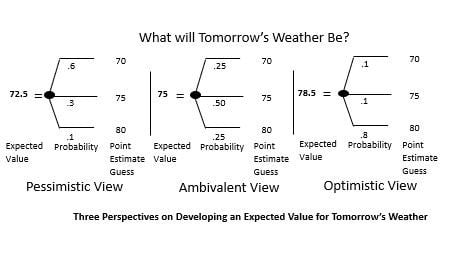
By: Peter J McAliney
Many leaders in organizations are turning to scenario planning to address the uncertainty associated with the impact of the COVID pandemic on major resource allocation and decisions they need to make for their organization. Scenario planning, first introduced by Herman Kahn through his work with the military at the RAND corporation in the 1950s, is a framework that many leaders are revisiting as a planning tool to evaluate decisions in the immediate future as well as supporting decisions that need to be made over longer-term time horizons.
There is no doubt that scenario planning is a powerful tool. That said, delivering a quality decision from a scenario planning exercise requires the appropriate consideration of relevant uncertainties, biases, and data. Drawing from a framework influenced by decision analysis, robust scenario planning can be illustrated by the following diagram:

Every organization is unique. As such, they will have unique circumstances that inform their assessment of particular uncertainties. Assessment of these uncertainties will be influenced by biases that individuals on the leadership team – and in some cases, the board – bring to the scenario planning exercise. These uncertainties will then impact the way data is evaluated and used to support decisions.
For those leadership teams that are deeply involved in scenario planning exercises, I will present in three installments my thoughts garnered from twenty-five plus years of consulting on how to think about these three elements – uncertainty, bias, and data – to support a management team's ability to make quality decisions, ones that will increase the probability of experiencing desired outcomes for their organization.
I will discuss the three elements that go into a scenario planning exercise – uncertainty, bias, and data. This part addresses uncertainty. Part two will address biases and part three will address the use of data in scenario planning.
Uncertainty
Uncertainty is another term for describing risk. One of the key considerations when thinking about risk is not to try to affix a single point estimate to it – that implies that you have certainty – but rather developing a continuum, or distribution. For example, if you were going to be rewarded for a correct guess about tomorrow’s temperature would you be more comfortable stating, “I believe tomorrow‘s temperature will be between 70 and 80 degrees” or saying, “I believe tomorrow’s temperature will be 75 degrees.”
If you were pressed to come up with a single estimate, however, there is an even more nuanced way to inform your decision. That is through answering with an expected value for the temperature, which is a weighted average of your guesses at what the probability will be for a set number of temperatures.
A simple example can illustrate the point, but – and a big but – the expected value is determined by an individual’s world view, their own understanding of weather patterns, biases (see part 2 of this discussion), and other factors specific to the individual. So, if three individuals were asked for their predicted weather for tomorrow using an expected value framework, they might come up with three different answers.

Probability, then, is the way to quantify risk/uncertainty. Speaking in the language of probability is important in a leadership team for two reasons:


Using this construct of probability relies upon the assessment of the probabilities associated with the risks and creates a probability distribution associated for each of the individuals on the leadership team's intrinsic perspective on risk (the science of assessing is a topic for another treatment, but suffice it to say, if the assessment of risk is not conducted with integrity, then the use of probability analysis is moot).
The power of this approach is that assessing probability distributions helps measure and resolve differences among members of the leadership team. With a distribution, although individuals may dispute individual point estimates provided by their colleagues, they can more readily accept probability distributions as a way of assessing the risk. Additionally, probability distributions allow for sensitivity analysis, which can test the importance of disagreements. Valuable time can be directed to those disagreements that carry a big impact, not those that have minimal impact on the ultimate decision or set of decisions (oftentimes pet projects can be easily ferreted out through such a process).
It is import that risk assessment is done in a thorough, honest, and uncompromising fashion by a professional who is skilled in the science of assessment in order to eliminate individual members of the leaderships’ biases, to uncover individuals’ hidden agendas (conscious or unconscious), and lead everyone on the leadership team to have a common understanding on the range and depth of risks that they need to consider.
Questions for Leaders to Consider
Organizational or unit leaders need to honestly answer a series of questions to determine if their scenario planning process adequately addresses uncertainty to inform quality decision making. Specifically:
- Have all internal and external risks been identified?
- What stakeholders have had a voice in evaluating these risks? Are all stakeholders that should be involved, involved? Are any voices in the conversation overriding others?
- How have these risks been addressed/assessed in the scenario planning process?
- Which risks have the widest disagreement among stakeholders (i.e., the flattest probability distribution)?
- Does the team have a data-driven sense as to which risks pose the greatest potential harm (or create the greatest opportunity) for the organization?
- Is the team spending their time on discussing the most important risks (which may not be the ones that have the most emotional energy behind them)?
About the author:
Peter McAliney is a Principal Consultant at Chenery & Company, Inc., a consulting practice that works with senior higher education administrators, unions, legislators, lobbyists, and public policy organizations to foster product, portfolio, and organizational innovation. He is the co-author of Painless Project Management (Wiley, 2007). He can be reached at https://www.linkedin.com/in/pjmcaliney/ and tweets at @pjmcaliney.